Items
Mediator is exactly
Healthcare
-
2020-12-20
Declaring Patient 100 Deceased Life as a NYC EMT During an Unprecedented Global Pandemic
December 20th, 2020, started as an “ordinary” day for myself and my colleagues. 1600 hours rolled around, and my partner and I clocked in for our sixteen-hour tour. We had finally adjusted to our new routine of working a mandatory sixteen hours as opposed to twelve. As emergency medical technicians, we were at the forefront of the COVID-19 Pandemic in New York City. Our region was hit hard by COVID-19 and seemed to be the epicenter of the pandemic for longer than one could ever imagine. For NYC EMS workers before the pandemic, it was common to see around three thousand calls for service daily across all five boroughs. Once the pandemic struck the call volume rapidly overwhelmed the city's EMS resources as they answered a record seven thousand calls for service daily. My partner and I made small talk as we awaited the arrival of the outgoing crew. The day shift arrived back at the station exhausted, defeated, and depressed. They informed us that during their sixteen-hour tour, they had answered twenty calls for service; fifteen of which were for critically ill patients. After some small talk, we exchanged medication kits and radios as it was our turn to serve the great city. Immediately after logging on to the computer system and giving the dispatch center an in-service signal, we were called for a priority one assignment. Our unit was called to the scene of a thirty-two-year-old mother diagnosed with COVID-19 who had stopped breathing. As we arrived at the scene, I donned my four-day-old n95 mask, as well as a makeshift gown made from a garbage bag with holes cut for my head and arms. As we made our way up the five flights of stairs the sound of the screams grew louder. We entered the apartment to find a woman lying on the couch who was clinically deceased. For the next forty-five minutes, my partner and I worked feverishly to perform cardiopulmonary resuscitation, defibrillation, endotracheal intubation, as well as intravenous cardiac drug administration. Despite our efforts, the patient continued to show no signs of life, my partner and I locked eyes and nodded at one another, knowing we had done all that we possibly could have for this patient. I switched the cardiac monitor off and looked down at my watch as I said, “Time of death 1705 hours”. Our next responsibility was to inform the patient’s husband and children of her passing. While you train for many hours to show empathy after death, this task never gets easier. My partner sat in the kitchen with the family, while I prepared the paperwork for a death pronouncement. My partner delivered the life-shattering news and did her best to console a grieving family. After returning to our ambulance to decontaminate our equipment and restock for the next assignment I opened my logbook to record the death encounter. My heart sank as I turned to the next open page which was page number one hundred. In less than one year, I had pronounced one hundred patients deceased from COVID-related illnesses. In my short career before the pandemic, I had only pronounced about fifteen patients deceased. It was at that moment that the true magnitude of the pandemic sank in. COVID-19 had decimated the way of New York City life, the previously bustling city remained shuttered as many remained in indoors in hopes of preventing illness. Before the pandemic, I had known the city as a connection of vibrant neighborhoods filled with culture and joy. COVID-19 had robbed our great city of its life and color; for the next two years, the city appeared black and white as a shell of its previous greatness. These thoughts quickly fled my mind as my unit was once again called to another high-priority assignment. We were called to a sixteen-year-old man diagnosed with asthma, who had recently contracted COVID-19 and was struggling to breathe. Our days were filled with assignments like these, often with no rest, and zero opportunities for a meal break. Nearly one year into the COVID-19 pandemic, my colleagues and I were exhausted, and our mental health and morale were at an all-time low. Many of my collogues fell ill, and four of them died because of COVID-19. We had often asked ourselves and one another; “Why Us? Why are we still doing this job? and when will this end?” While these times were challenging, we understood that we had been called to work in EMS because of our passion for caring for those in need. Day in and day out, we found strength and resilience in one another. My colleagues and I had implemented daily peer support groups in which all were welcome to come and speak about their experiences. While COVID-19 seemed to pull the world apart, it pulled EMS staff closer together. Enemies quickly became friends, and seemingly overnight we all became family. Our perspectives were unique as we were the only healthcare providers to enter the homes of the ill, and feverishly worked to care for them under less-than-ideal conditions. As the number of COVID-19 cases began to decline with the introduction of the vaccine, my colleagues and I felt we could breathe a sigh of relief. As quickly as the pandemic entered our great city, it seemed to vanish even faster. Each shift brought hope as we watched businesses reopen, and the streets were once again filled with color and culture. While we experienced new variants and spikes in COVID-19 cases, we felt that our great city had become stronger and more resilient. While COVID has changed our way of life, one thing I will never forget is the comradery we built amongst the emergency medical services personnel. To this day my colleagues remain a second family in which I can confide after a difficult shift. While COVID was one of the greatest challenges faced by New York City, I feel that it has made us stronger and more resilient than ever. -
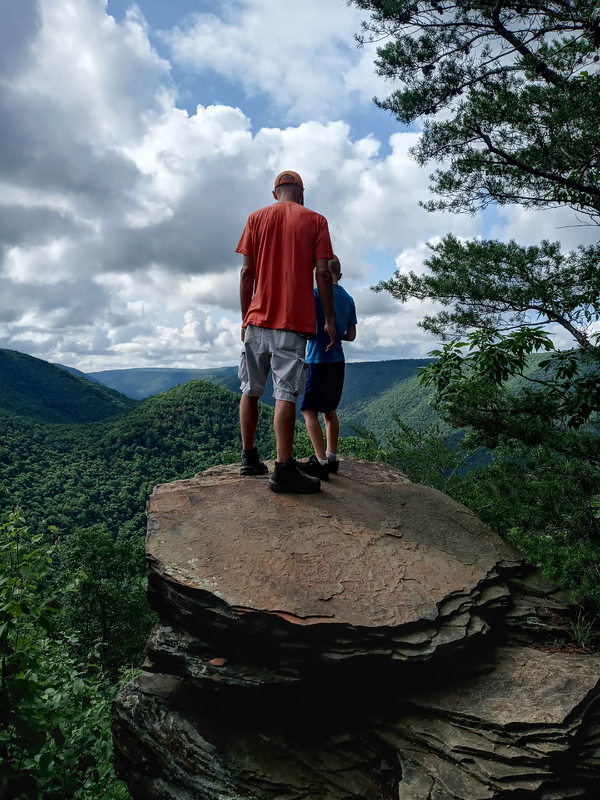 2021-05-15
2021-05-15A Measure of Peace During a Global Pandemic
During the COVID-19 pandemic I was working in health care for an agency. This meant that I traveled from facility to facility where there were staffing shortages and predominantly worked in the covid units. It was a strange experience to travel across Pennsylvania during this time and have little to no traffic that would typically have existed were there not any restrictions enacted. Therefore, when the restrictions were lifted, I did not feel an urge to travel to any great extent as I never stopped working during the lockdowns and if anything, my hours were significantly increased to the point of constant exhaustion. However, when the restrictions were lifted, I found myself in need of outdoor therapy. I am an avid hiker and enjoy the silence that trails offer. I have found that my favorite trail to visit is the Golden Eagle Trail, or as my children refer to it “Rattlesnake Ridge.” While the restrictions were lifting in most places at the time, I hardly noticed because in health care they remained for a much longer period. On many occasions in 2021, my family accompanied me to the Golden Eagle Trail to step away from society and unwind as a family without feeling the pressure of all the changes that were brought about by the pandemic. These trips provided me with lasting memories of my son reaching for my hand for security when walking along a thin train with a steep drop alongside it, my husband helping steady me across slippery rocks, and more. The photos from these trips are everlasting reminders of the happiness that hiking, especially with my family, bring me. Moments like these are to me the important moments in life. -
 04/15/2020
04/15/2020Christine De Ocampo Oral History, 2020/04/15
-
 2023-05-14
2023-05-14Pandemics are Not "Great Equalizers" - Comparing COVID-19 to the Bubonic Plague Outbreak of 1870-1905
With the designation of COVID-19 as a "public health emergency" by the Centers for Disease Control and Prevention (CDC) ending as of May 11, 2023, public healthcare facilities throughout the US are rolling back protections they once employed to try to keep people safer during this ongoing pandemic. So, as this unit asks of us students, are pandemics the “great equalizers” in terms of social inequalities, and is there more equality now that the "emergency" has been deemed to be over? I argue that this is not the case, as immune compromised and disabled people have been more or less left for dead. A huge swath of healthcare facilities have removed mask mandates for care providers and hospital visitors, which leaves vulnerable and immune compromised people at a much higher risk of getting COVID-19 while receiving the medical care that is necessary for them to manage their conditions. In response, people and organizations, such as the Massachusetts Coalition for Health Equity in the tweet above, have begun to mobilize in favor of maintaining COVID-19 protections in healthcare settings by organizing strikes, protests, petitions, and phone banks to public officials. The reasons for maintaining COVID precuations such as mask mandates, access to COVID tests, and enhanced filtration in healthcare settings are clear. As the Massachusetts Coalition for Health Equity describes in their petition titled "Patient Strike Authorization Vote," the CDC "advises immunocompromised people to avoid crowded indoor settings, which now includes all healthcare institutions without universal masking," essentially maintaining that COVID is dangerous to immune compromised people while giving them no option but to risk exposure if they want to receive their necessary healthcare (Patient Strike Authorization Vote). The petition text explains that "[n]ational leaders in hospital epidemiology argue that universal masking should become the new standard of care, as gloves became with HIV" in order to keep people with compromised immune systems such as young children and elders safe (Patient Strike Authorization Vote). Currently, disabled and immune compromised people "are being locked out of safe healthcare" and are facing discrimination that makes them unwelcome and unsafe in healthcare settings (Massachusetts Coalition for Health Equity). In order to relate this modern COVID-19 pandemic to our course materials and demonstrate that discriminatory treatment during times of disease is not new, I will compare the above post to points from the text "The Chinese as Medical Scapegoats In San Francisco, 1870-1905" by Joan B. Trauner. This text discusses the discrimination against Chinese and other East Asian people living in San Francisco's Chinatown during a bubonic plague outbreak in the late nineteenth century. Sinophobic and anti-Asian sentiments, similar to those that arose during the epidemic Trauner details, have also been evident throughout the COVID-19 pandemic, so much so that even US President Donald Trump referred to COVID-19 as the "China virus." Ableism has also been prevalent throughout the COVID pandemic, as many people no longer care about the effects of the virus, because it harms disabled and immune compromised people most, especially people who also face racial discrimination in healthcare. Trauner explains that, because white people in the US believed the plague primarily affected Chinese and other Asian people, and because plagues were bad for business,"[t]he governor of California, Henry T. Gage, and executives of big business and of the large railroads, in conjunction with the San Francisco Board of Trade, the San Francisco Chamber of Commerce, and the Merchants Association, were all determined to prove that the plague did not exist in San Francisco" (78). The author of the Patient Strike Authorization Vote argues that today, we see a similar pro-business sentiment that comes at the expense of immune compromised people who are more likely to get sick with and die from COVID-19, writing: "Hospitals that remove masks and surveillance testing are making a value judgement about our lives, because they want to preserve their profit margins" (Patient Strike Authorization Vote). The CDC's ending of the COVID-19 public health emergency designation and the resulting halt of COVID mitigation procedures indicate that people are ignoring the needs of immune compromised people so that everyone can feel more comfortable going "back to normal" and maintaining consumption habits that are desired by businesses. Additionally, in both the past plague outbreak and the current pandemic, public health officials have shown hesitancy to give people vital information, which has led to harm. As Trauner explains, during the bubonic plague epidemic, "San Francisco Mayor Eugene Schmitz refused to approve the printing of health reports and vital statistics and even attempted to remove from office four members of the Board of Health who persisted in stating that plague existed in San Francisco" (79). Today, because the public health emergency designation ended on May 11th, 2023, the CDC is "no longer reporting aggregate cases and deaths, COVID-19 Community Levels, COVID-19 Community Transmission Levels, or COVID-19 Electronic Laboratory Reporting (CELR) data," all of which have been used to determine the severity of the situation throughout the pandemic (COVID Data Tracker). Meanwhile, over one thousand people are dying of COVID every single week, but COVID transmission levels are not being tracked, so people cannot know how many COVID positive cases there are in their county and how likely they are to contract the virus by going out in public (COVID Data Tracker). Another similarity between the COVID-19 pandemic and the bubonic plague outbreak of the late nineteenth century lies in the responses of the people facing discriminatory treatment in public health settings during these respective disease outbreaks. Trauner writes that before, during, and after the bubonic plague outbreak, Chinese businesses and health practitioners constructed and operated their own hospitals that would treat the people of Chinatown, because they were not welcome at other hospitals due to racial discrimination (81). Trauner explains that "[e]arly Chinese immigrants realized the necessity of banding together and providing for their own health care needs," in light of the government abandoning their health needs (81). Activists and organizations like the Massachusetts Coalition for Health Equity are currently banding together and fighting to get better and safer care for immune compromised people during the COVID-19 outbreak, as they are also facing discrimination at hospitals rolling back COVID precautions, because these spaces are not safe for them. The organizing they are doing to try to make healthcare settings safer for immune compromised people looks different, as no one is proposing the creation of immunocompromised-specific hospitals. They are fighting for better treatment, still, using slogans like "We Do Not Consent to Get COVID at the Doctor," and urging people that "[w]e must take collective action to prevent this mass violation of our human rights and federal rights to safe care," as stipulated under the Americans with Disabilities Act (Massachusetts Coalition for Health Equity). In both disease outbreaks, it has been the duty of those being discriminated against to take care of and advocate for themselves. So, in fact, pandemics are not "great equalizers"; in reality, they not only make pre-existing inequities even more visible, but exacerbate them even further. As Trauner argues, "Health policy [...] manifests not only the state of the medical sciences, but the expectations and the value system of society-at-large," and as such, if society-at-large is racist and ableist, then the health policies put into place will reflect these discriminatory values (70). These governmental measures come at a cost to everyone, and especially those facing racist and ableist discrimination. Had the nineteenth-century bubonic plague outbreak been determined an emergency and treated as a serious threat in spite of sinophobic and anti-Asian sentiments, perhaps more research could have been carried out sooner, and more lives could have been saved. If people in the US continue to take the COVID-19 pandemic seriously and not dismiss the pleas of immune compromised and disabled people to continue precautions, perhaps loss of life and further disablement from COVID infection can be mitigated. -
 2021-08-20
2021-08-20Hospital-Bed Interviews
A comic strip about Covid-19 -
 11/29/2021
11/29/2021Don Knutson Oral HIstory, 11/29/2021
Don Knutson is the Rescue Squad Director for the Village of Colfax Wisconsin. In the interview, he goes into detail about his job and how it changed because of Covid. As he has taken care of patients that go by ambulance but as a director and how he has seen things change in the profession. He also is the health advisor for the Village of Colfax which was the main source for the community. While he also shares how his work life has also affected his personal life because of the added reasonability from Covid. Finally, he comments on how the political atmosphere has affected the pandemic. -
 12/08/2021
12/08/2021Shelby Kolar Oral History, 2021/12/08
Shelby Kolar is a lifelong Eau Claire resident and Director of Nursing at a large long-term care facility in Eau Claire. In this interview, Shelby discusses how the COVID-19 pandemic has impacted her work and discusses how it has affected her family and friends. Shelby responded to my interview request because she felt it was important to share the high impact of COVID-19 on long-term care facilities and the geriatric population she cares for. Shelby highlights the emotional and mental toll of caring for the elderly during the pandemic and provides a deeper look into senior care as a whole. Shelby touches upon how her kids and husband managed the pandemic and the highs and lows of spending so much time together. -
 12/08/2021
12/08/2021Eric Schwerdt Oral History, 2021/12/08
Eric Schwerdt, born and raised in Duluth, MN, is a non-traditional student and ICU nurse at the Mayo Clinic in Eau Claire, WI. Eric earned his BA from the University of Minnesota-Duluth in 2012. Later, he received his ADN from Lake Superior College, and finally his BSN from St. Scholastica. In this interview, Eric talks about the traumatic and demanding role of an ICU nurse during a pandemic - describing haunting images of sick patients resembling more machines than men, and the occasional peace nurses can provide for suffering families. He also delves into the science of COVID, the vaccines, and the complicated undertaking of educating a reluctant public about them. Throughout the interview, Eric also reveals how his personal struggles with mental health impact his experiences and inform his perspectives in the era of COVID-19. -
 12/10/2021
12/10/2021Jason Trzebiatowski Oral History, 2021/12/10
In this interview, Jason Trzebiatowski, an EMT and Resident Assistant at the University of Wisconsin-Eau Claire, discusses some of the challenges and concerns facing first responders and other care workers during the COVID-19 pandemic. He highlights the changes within the medical industry as it pertains to first responders, challenges he has faced as an RA with concerns from his residents, and the impact that the media has played in altering people’s perception of this virus and the institutions erected to fight it, including how much people’s perceptions of institutions like the CDC and the government, in general, have shifted over the past few years. -
 11/27/2021
11/27/2021Rebecca Ferber Oral HIstory, 2021/11/27
Rebecca Lynn Ferber is a resident of Oronoco, MN, and currently works for the Mayo Clinic in Rochester as a CRNA (Certified Registered Nurse Anesthetist). In this interview, Rebecca talks about how COVID has affected her job as a CRNA and Mayo Clinic as a whole as well as a mom and wife. She also talks about how it has affected her family and friends and how some of her relationships have been strained because of different views on COVID. She touches on how it not only affects people's physical health but mental health as well and gives some advice for future generations. -
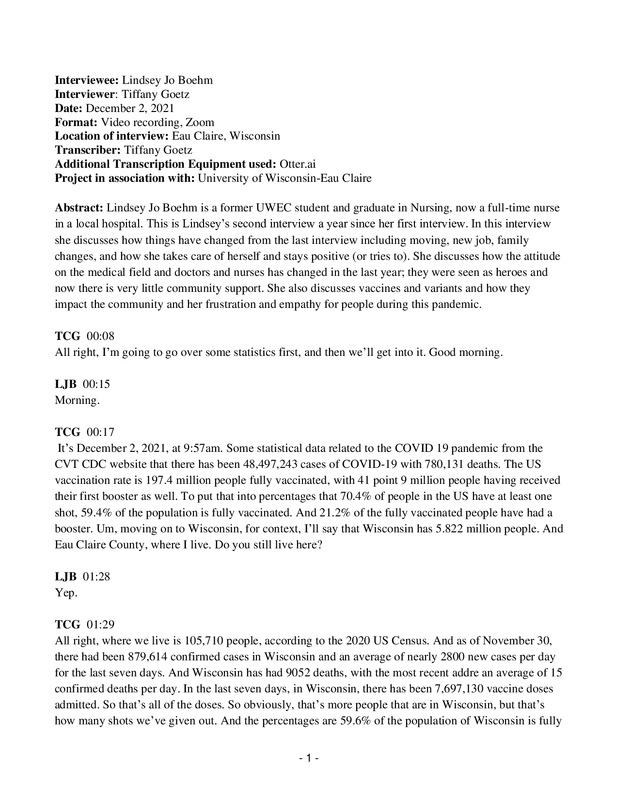 12/02/2021
12/02/2021Lindsey Jo Boehm Oral History, 2021/12/02
Lindsey Jo Boehm is a former UWEC student and graduate in Nursing, now a full-time nurse in a local hospital. This is Lindsey’s second interview a year since her first interview. In this interview, she discusses how things have changed from the last interview including moving, a new job, family changes, and how she takes care of herself and stays positive (or tries to). She discusses how the attitude in the medical field and doctors and nurses has changed in the last year; they were seen as heroes and now there is very little community support. She also discusses vaccines and variants and how they impact the community and her frustration and empathy for people during this pandemic. -
 12/03/2021
12/03/2021Sarah Benthein Oral History, 2021/12/03
Sarah Benthein was born and raised in Appleton, Wisconsin, and currently resides in San Diego, California working as a travel nurse. Being that she has been working as a nurse, Sarah has been able to see firsthand how the health system has been affected, and changed by the pandemic, and her perspective will give individuals a first-hand account of many of these changes. Throughout much of this interview, Sarah discusses many of the different ways in which Covid 19, including such things as travel, working, and recreational activities. She shares how restrictions in San Diego have been taken much more seriously than in Wisconsin, and because of that, her life has changed dramatically from what it was prior to Covid 19 occurring. Sarah also reflects on how drastically travel changed in regards to Covid, especially owing to how far from home she lives. -
 2023-03-15
2023-03-15Kit Heintzman Oral History, 2023/03/15
Kit Heintzman is a recovering academic currently residing in Lenapehoking, who was trained in the medical humanities with a special interest in queer theory, animals, and the history of nationalism. Kit has developed a singular collection of oral histories of the pandemic for A Journal of the Plague Year, collected from a range of individuals with widely diverse experiences. That collection addresses significant silences surrounding the pandemic broadly and within JOTPY more narrowly. In this item Kit is interviewed by Angelica and Erin, both with Arizona State University, about Kits collection process. -
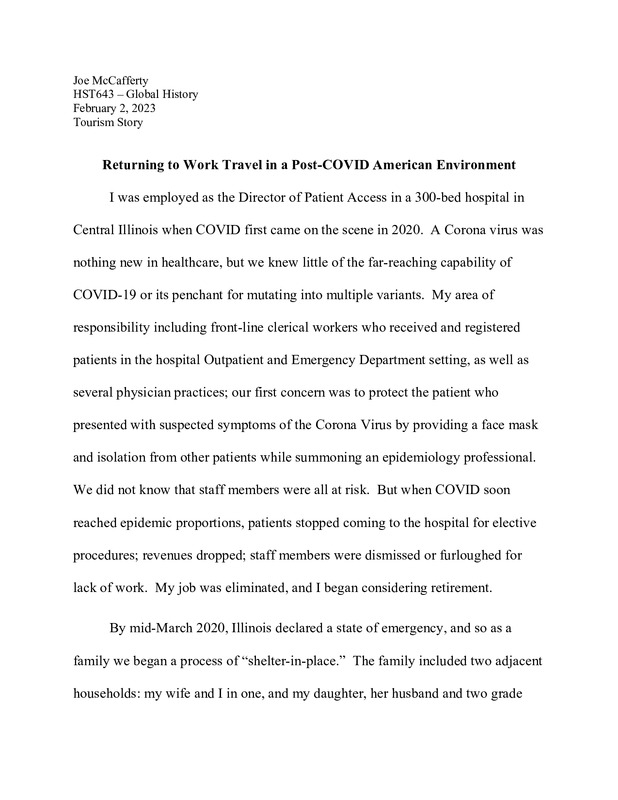 2020-02-23
2020-02-23Return to Travel After Covid
Enduring COVID restrictions impacting travel. -
2023-01-22
COVID Restrictions and Visiting Mom.
My mother has special needs and since 2014, lived in a townhome with three roommates, facilitated by Penn Foundation, a behavioral healthcare provider. I lived only 10 minutes away, and once a week I would visit her on my days off. I would bring fast food or pizza and we would watch movies together in her room. When the pandemic began, Penn Foundation - like most other healthcare facilities - imposed tight restrictions for the safety of those under their care. As a result, I was unable to visit my mother for half a year, and after restrictions were loosened, our visits were relegated to sitting on her front porch eating and talking. Due to a deterioration in her condition, she was moved to a nursing facility. We never got to have another movie day. The pandemic had changed the way I visit my mother forever. -
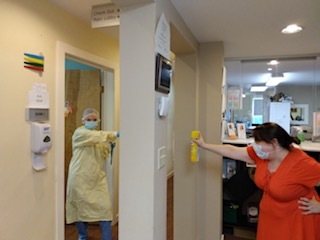 2020-06-21
2020-06-21Disinfectant Battle at the Doctor's Office
The photo was taken at the beginning of the pandemic, probably a Friday in the summer because I was not wearing scrubs (casual Fridays). I was working in a pediatric office as a medical assistant in Litchfield County, Connecticut. If you know anything about that area, it was scary at the time because all of the families with any means in NYC were fleeing the city and coming to Litchfield and Fairfield Counties. We were quite nervous at the time that they would spread covid to our communities at the same rate as it was in NYC. Luckily it did not happen. It was a scary time, as every day we would get the ding in the morning and the end of the day of an email notification telling us how many deaths were in local hospitals, how many beds were left (spoiler- none), how much PPE was available (again, none) etc. We were so short on PPE we had to reuse our masks for a whole week (unless exposed of course). I can still remember the feeling of the little fabric “firs” that would start to itch my face after a few days, and the nice smelling essential oils we put in them to make wearing them tolerable- I used citrus smells, and my coworker used coconut. The worst was the lack of cleaning and disinfecting products. We tried to not see patients that were even remotely sick with covid symptoms because we did not have enough cleaner to disinfect the rooms after they left. When we were fortunate enough to get a new bottle of Lysol, we would take fun photos like this one of me threatening my coworker whom I suspected was covered in germs. Little moments like this helped to alleviate the stress of the moments when that email ding came in at the end of the day. -
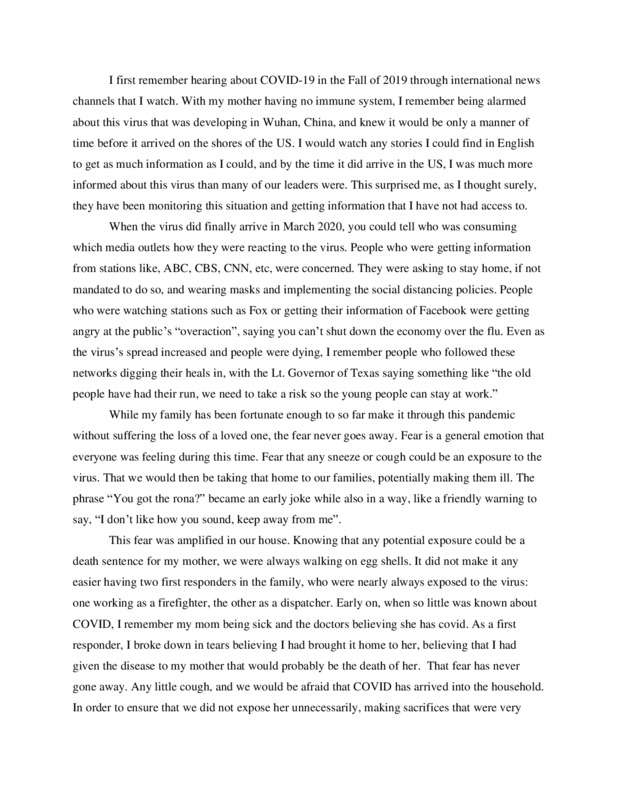 2022-07-24
2022-07-24Fear for My Mother's Saefty
I've written a short story centered around my experience with fear of this virus, particularly focusing on how my fear is heighten with an immuno-compromised mother. I wrote about how the media the people around me consumed affected their behavior and played a role within my fear and the impact it had on my mother. This story says two things about this pandemic I think: it shows the impact that information had/has on how people approach the virus and the emotional toll the pandemic had on people living their daily lives. What I've submitted is important because it validates what Americans have experienced. Many Americans -
 2020-03
2020-03Navigating through medical care during the beginning of the Pandemic
During the beginning of the pandemic, I was taking care of a sick family member who needed multiple surgeries and doctors appointments. The sickness started prior to the pandemic, but continued through the beginning of March 2020. I remember having to wait outside in my car while she was in the hospital getting surgery and not being able to go inside while she was admitted to a room in the hospital. The stress and anxiety I felt was like none other I had felt before. Not only did I feel the stress of not being in that room to be an advocate for my family member, but also the true fear of her contracting COVID19 while having a compromised immune system. During this time, my work offered a six week paid pandemic leave that I utilized to take care of this family member at home. This reduced a lot of stress because I was able to quarantine us while she healed and take care of her. I will always be appreciative of my job for allowing this opportunity. As the world adapted, so did we, but I do have to say the scariest times were navigating the health care systems while everyone was attempting to lower the Covid19 rates. -
 2022-06-10
2022-06-10Arkansas prison doctors and ivermectin
This is a story detailing Arkansas' Medical Board dismissing charges against a Washington County prison doctor for treating prisoners with ivermectin. Arkansas' Medical Board has not explicitly denounced the drug as a treatment for COVID-19, and many physicians prescribe the drug. This particular physician treated several unknowing prisoners with ivermectin in order to combat rising covid cases in the Washington County Jail in April. This dismissal of charges by the Medical Board reveals a deeper skepticism of the pandemic in Arkansas and a willingness of the board to allow physicians to treat their patients as they ultimately see fit with minimal regulations. I feel it also reveals a deeper understanding of Arkansas' prison system due to the prisoners not being informed of what was given to them, and therefore without consent. -
 2022-07-11
2022-07-11LGBTQ+ VA Healthcare in Arkansas in the wake of COVID
This is the Arkansas Veterans Affairs website listing specific resources for LGBTQ+ veterans in Arkansas. This site places a specific emphasis on Central Arkansas due to the heavy LGBTQ+ population in that area. In order to combat COVID-19, this site focuses on not only concerted vaccine rollout for LGBTQ+ vets, but also lists mental health resources in order to combat COVID-19. I think this shows a particular vulnerability to a select group and how COVID-19 can reach anyone. Indeed, it is essential that at-risk groups such as the LGBTQ+ community are not overlooked in the age of COVID, and it is encouraging to see the VA take steps to assure this is the case. -
 2022-06-23
2022-06-23Smiles on and masks off
This is an Instagram post from physicianendocrinologist. This is about a changing mask policy at the endocrinologist office that posted this. It encourages people that are immunocompromised to wear masks though. -
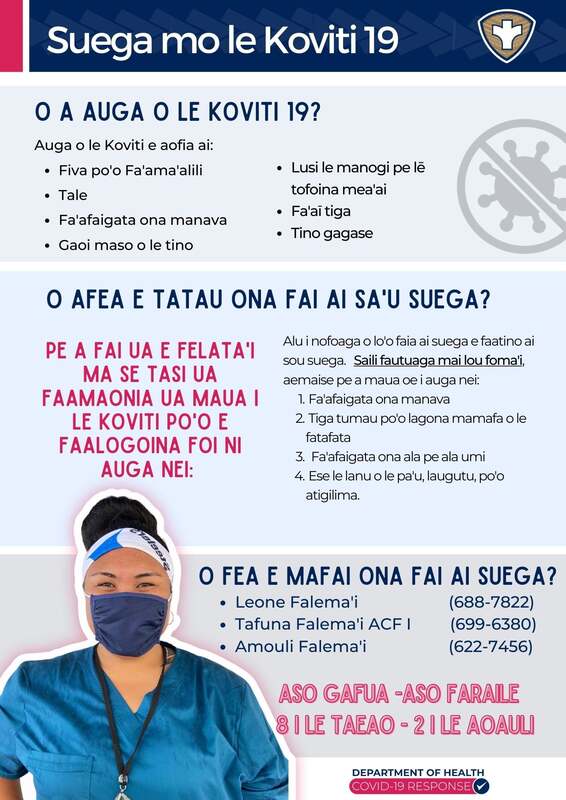 2022-02
2022-02American Samoa COVID-19 Testing Schedule
The American Samoa Department of Health released this flyer in both English and Samoan languages for the public so they would know what time and day COVID testing sites are open, where they are located, and the number to call for each site if they need further information. Not only was this released online but placed in every store of the island. -
 2022-02
2022-02Wear a Mask: Fa'aaoga Puni Fofoga
With the rise of covid cases in American Samoa at the beginning of this year in February, the Department of American Samoa Health Department partnered up with the American Samoa government to make sure that the people of American Samoa are well aware of what to do to combat COVID. It is one of the many flyers and ads released by the ASDOH for the public of American Samoa. They are released in both the English and Samoan languages. This flyer is for people to wear a mask and in the Samoan language, fa'aaoga puni fofoga. -
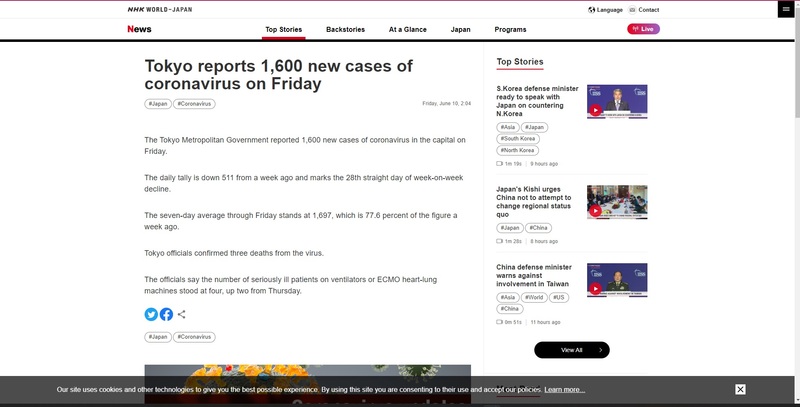 2022-06-10
2022-06-10Tokyo reports 1,600 new cases of coronavirus on Friday
This is an article from NHK World-Japan. There have been more COVID-19 cases reported in Tokyo, Japan. However, the article reports that the cases have been in decline despite these new 1,600 cases. The Japan Times website, they have a timeline that discusses the same 1,600 new cases, but also shows an Outbreak map of Japan's current cases, deaths, testing, and other things. This is a reminder that Japan is still struggling with the virus, but there is some hope with the cases decreasing weekly. -
 2022-05-30
2022-05-30New guidelines for face masks in Japan
Japan, as of May 30th, 2022, is relaxing the face mask guidelines. For the most part, masks do not need to be worn outdoors except when the elderly are in close quarters to other people. Indoors, masks are still required indoors except in the case of when someone is in little to no conversation, which the article shows in a chart. The chart's example states walking around museums and libraries where there is little to no conversation. One of the reasons for why Japan is relaxing face masks is because summer is approaching and the temperature will rise. There are fears about face masks causing heatstroke. In Japan, temperatures can range from 70-90 degrees F, but the summers are hot and humid too. So, it makes sense to relax the restrictions, especially in the outdoors. -
 2022-01-13
2022-01-13Addressing Trauma from COVID-19 on Students and Teachers
COVID-19 has had a huge impact on both students and teachers. Not only has there been learning gaps, but there has also been an impact on the social and emotional well-being of teachers and students. Many experts now say that these issues need to be addressed before focusing more on academics. -
 2020-08-06
2020-08-06Knock Knock
During the summer of 2020 I was taken from my current unit (where I work as a nurse) back to the ICU to care for the overflowing patients. The ICU is a very noisy place, but one noise that was new was the knocking. To go into a COVID patient's room you have to put on booties, a full length gown, two pairs of gloves, an N95 mask and a surgical mask along with eye protection. It is a lengthy process so once you are in the room you don't leave until all tasks are complete. So if you need something when you’re in there you would knock on the glass doors of the patient's room and one of the helper nurses would come and read what you had written on the door in a marker and get the items for you. It was so quite in the rooms, no families were allowed so it was you, the machines and the patient. It was so hot you could feel the sweat dripping down your back and pooling in the arms of your gown. It was a very isolating feeling, usually there are lots of hands and people in your rooms with you to help or just to chat but not during COVID. The knock-knock could be heard all down the hall. It reminds me of the isolation we all experienced during this time and also how resilient we are and how helpful nurses are to each other. Nursing is a team sport. It is a sound and an experience I will never forget. -
 2022-05-28
2022-05-28Shanghai edges towards COVID reopening as Beijing plans to ease curbs
This is a news story from Reuters. After intense lockdowns, Shanghai is looking to reopen again. Shanghai officials urged continued vigilance, even though the vast majority of its 25 million residents live in areas that are in the lowest-risk "prevention" category. "Wear masks in public, no gathering and keep social distance," Zhao Dandan, deputy director of the Shanghai Municipal Health Commission, told a daily news conference. Similar measures are being taken in Beijing, where things are reopening there too, but with restriction. Starting on Sunday, shopping malls, libraries, museums, theatres and gyms will be allowed to reopen, with limits on numbers of people, in the eight of Beijing's 16 districts that have seen no community cases for seven consecutive days. -
 2022-05-16
2022-05-16Stigma During the COVID-19 Pandemic in Japan
During the COVID-19 pandemic, healthcare workers and patients in Japan suffered from the stigma. According to the article, “In Japan, coronavirus discrimination proves almost as hard to eradicate as the disease,” healthcare workers and their families are discriminated against as if they are “germs” that people need to avoid contact with. The patients of the virus are also stigmatized, and such a phenomenon of blaming victims has been seen many times throughout Japanese history. As this article represents, health care workers in Japan were stigmatized and discriminate against because of the potential risks of COVID-19 infections. According to Goffman, the greek definition of stigma “[refers] to bodily signs designed to expose something unusual and bad about the moral status of the signifier” (131). Nowadays, its definition has expanded to negative images of physical and social attributes and their interpretation in a social context. The stigma of healthcare workers in Japan is peculiar to this pandemic, and this could be because the situation overturned the expectations people had about healthcare workers. Healthcare workers are supposed to help people with diseases, but because of the pandemic, they are seen as the ones with higher risks of carrying the virus as they have more interaction with those who have been infected. As a result, people become afraid of interacting with healthcare workers, which made this job stigmatized. The article shows that Japanese people reject to interact with healthcare workers and their families during the pandemic. One of the common consequences of being stigmatized is that stigmatized people become separated from other people as they are treated differently. According to Goffman, “[the] responses of the normal and of the stigmatized that have been considered so far are ones which can occur over protracted periods of time and in isolation from current contacts between normals and stigmatized" (135). As Goffman illustrates, health care workers were stigmatized and separated from society at the beginning of the pandemic. Some people even believe that “the person with a stigma is not quite human” as Goffman states, which lead to an extreme reaction by people around health care workers. For instance, healthcare workers have been receiving death threats because other people see them as if they are the potential source of the disease rather than the same humans who are fighting the pandemic together. Such a reaction is similar to how children bully other children based on differences in attributes. One of the typical ways of bullying is to call someone “germs” and avoid interactions, which is the same as the situation in this article. This pandemic revealed our natural tendency of staying away from others who have negative attributes, which indicates that a pandemic is not an equalizer but a source of discrimination. Another factor that could have contributed to the situation in Japan is social pressure existing in the country. The article mentions that there is strong social pressure in Japan to follow coronavirus directives and to cooperate for stopping the spreading of the virus; if people do not comply, they are strongly criticized or blamed by other Japanese people. In addition, surveys have shown that compared to Americans or Britons, more Japanese people agree with the idea that “If someone is infected with the coronavirus, I think it is their fault” (Denyer and Kashiwagi). According to Fei, there are behavioral norms that are maintained by tradition, called “ritual norms” (97). This kind of norm is regarded as moral behavior by people of the community so that they follow the norms regardless of laws or punishments (99). Although Fei discusses Chinese rural society, such norms have been established in Japan as well because Japanese society developed as an agricultural society where people in a community need to cooperate with each other. There used to be a tradition called murahachibu, which means excluding those who break the rules from 80 percent of social activities in the village with the exception of funerals and fires. Even though this practice is rarely seen in modern society, people still have a strong pressure to behave for the sake of society in order to maintain harmony. For example, Japanese people still feel obligated to wear masks after vaccines have been promoted even though there is no rule or punishment for not wearing masks. This feeling may occur because they believe it is moral or correct to refrain from doing something that possibly spreads the virus. Healthcare workers were not the only people who suffered from stigma, but COVID-19 patients were also blamed for their behavior that possibly contributed to their infection. In the article, a Japanese psychology professor mentions “a low tolerance for uncertainty” in Japanese people, indicating that they blame the patients to reduce their own fears derived from the uncertainty of the pandemic. This implies that COVID-19 patients become scapegoats for the pandemic itself. In the reading, Trauner writes that “the general acceptance of the germ theory in the 1880’s did little to dispel the popular belief that epidemic outbreaks were directly attributable to conditions within Chinatown” (73). This indicates that when people are uncertain about something scary, they try to identify what or who causes that disease or threat. Although people know that coronavirus is the cause of this pandemic, most people are afraid of germs and viruses because they are invisible. The article also demonstrates some cases of blaming victims in Japanese history, including leprosy patients, survivors of the 1945 atomic bombings, and evacuees of the 2011 Fukushima disaster. Such diseases and disasters involve complicated factors, so it is difficult to blame the causes directly. Therefore, individuals tend to blame patients or carriers of the virus during the pandemic instead of blaming the virus itself because they are visible and easy to avoid. References Erving Goffman (1976) “Stigma” :Chapter 10 “Selections from Stigma” Fei Xiaotong (1947) “From the Soil: the Foundations of Chinese Society” Joan B. Trauner, (1978) “The Chinese as Medical Scapegoats in San Francisco, 1870-1905 Simon Denyer and Akiko Kashiwagi (2020) “In Japan, coronavirus discrimination proves almost as hard to eradicate as the disease” -
 2022-03-09
2022-03-09The Pfizer Documents
This is a video regarding the safety of the Covid-19 Phizer vaccine reports that were recently released as of the making of both the video and this submission. It details the adverse events, the safe deliveries of the vaccine amongst an assortment of disorders, and the unhappiness of both the video creator and the viewers in the comments at the lack of transparency regarding the information surrounding the vaccine. -
 2022-05-12
2022-05-12Hygiene precautions Mall Aventura
These instructions are posted on the mirror in the kids' bathroom at Mall Aventura in Arequipa, Peru. -
 2021-12
2021-12The “Vaccine Passport” Agenda
This is information on vaccine passports by Swiss Policy Research. The overall message is that there is a correlation between totalitarianism and panic over the virus. This panic, in turn, has translated into governments around the world bringing up the possibility of vaccine passports. The vaccine passports may be used for more than vaccines, as they would be a way for the government to identify movement of individuals easier. The groups uses a number of ways to sway the audience, using information on what different organizations have funded, in addition to bringing up what other governments have said about the vaccine passports. Vaccine passports, according to this publication, really got traction from the digital identity lobby group ID2020 in February 2021, which has funding from both the Gates Foundation and the Rockefeller Foundation. The research foundation cites pushback against the vaccine passports too. Places like Ontario, Canada have had to take away the vaccine mandate for healthcare workers, as they would potentially lose many workers in the process. In Spain, they have been called "ineffective and unconstitutional." The publication ends by calling the pandemic a "plandemic," saying that it was likely lab-created for the purpose of controlling the populations more. I think given the information available, this is persuasive. There are links to where the claims come from, such as what Bill Gates says himself, as well as information on the Good Health Pass, which is a collaboration between many different organizations and their implementation of vaccine passports. In my own opinion, I find vaccine passports unconstitutional and an invasion of privacy. A vaccine passport makes it so you are forced to disclose personal health information to strangers in order to do things like grocery shopping, which I consider to be a potential HIPAA violation. It is also breech of the Fourth Amendment in the Constitution. If people feel inclined to get vaccinated, they should, but forcing people to do so through vaccine passports creates more overall distrust in the government. I have known people that would have otherwise have gotten the vaccine if it wasn't so forced. Even though vaccine passports were never mandated where I live, there have been people that have lost their livelihoods over not wanting to get vaccinated. I myself was very hesitant to get the vaccine for a while due to the way the government was handling it. Trying to implement vaccine passports and mandates has made it so society becomes more segregated, where unvaccinated would be forced to shop at different places, work at different places, and many other things. I am glad that the overall effort to actually do this has failed, but that is only because of many groups of people throughout the United States exercising their rights. I am pro-choice too, and I extend that reasoning to vaccine passports. People need bodily autonomy and vaccine mandates remove some of that. -
 2022-04-22
2022-04-22The Shanghai Lockdown. Seen from Another Angle
This is a screenshot of an article from globalresearch.ca about looking at the most recent Shanghai Lockdown. Yet, the article does not talk about the Shanghai lockdown until maybe halfway through the article. It goes on a tirade about how the 2002-2004 SARS outbreak went after the "Chinese race" and how it became an early trial for China before COVID. Then the author states that China has "mastered the disease" and managed to reopen its economy by the end of 2020, which leads to the conclusion that China's economic growth hardly suffered during the newest outbreak. The author asserts that China will surpass the U.S. economy in 3-4 years and then launches into a world history lesson about Cold War politics. The author tends to wander in the article, going from pandemic skepticism on vaccines sterilizing women, being lied to the government, or having HIV ingredients. Then somehow, Ukraine has virus labs...I don't know. Somehow, Russia is involved in this article, but I'm not sure why. I don't know how this is supposed to persuade its audience because the author goes all over the place with his points. I suppose skeptics will like the fact that the vaccine is being questioned here? Personally, I don't even understand why skeptics would want to read this because I think they would lose even more brain cells from just trying to read it. I think this article is just a gigantic mess and it makes my brain hurt. I find myself just not understanding a single thing that is being written in this article. I don't understand why anyone would even understand or like this article. It literally makes absolutely no sense and there are even typos in it. The look of this website and article makes me want to run my virus protection at least three times because I feel like they're going to infect my computer with a Trojan horse. -
 2022-05-03
2022-05-03Eranga Narangoda Oral History, 2022/05/03
It provides the pandemic perspective of Dr. Eranga Narangoda, a practitioner of internal medicine specializing in infectious disease, as he served on the front lines of Sri Lanka's COVID response. -
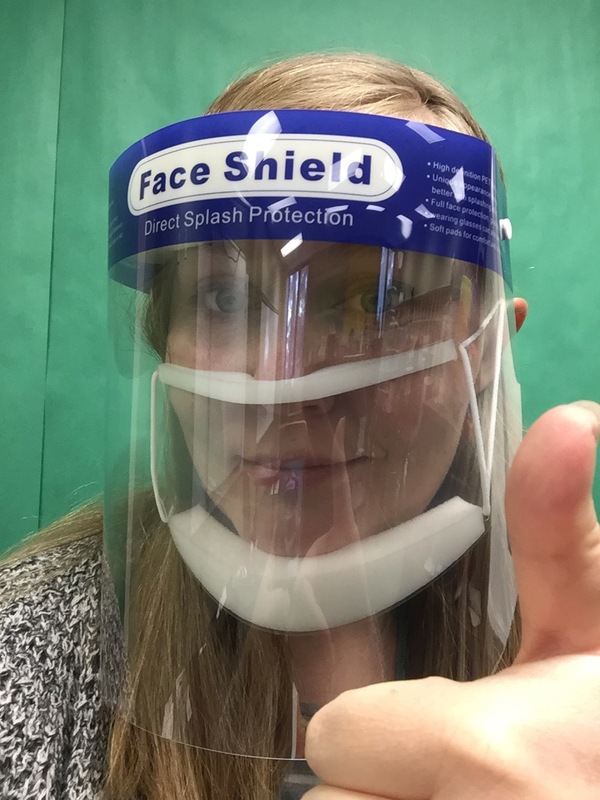 2020-03-15
2020-03-15Together and Apart
Flagstaff AZ. My husband was an occupational therapist who regularly worked in the ICU at Flagstaff Medical Center. I remember the week after the lockdown started (March 15th or so) the Covid-19 numbers were doubling every week at FMC. My husband started changing out of his scrubs and shoes in the garage. I was a speech therapist with the school district and we were all asked to stay home, which was good because I have two school-aged children. As the Covid numbers started to skyrocket in our region due to a devastating outbreak on the Navajo nation, my husband became more and more worried about bringing the virus home since there was a shortage of PPE. When it was announced that my own job would go remote and I would need to start scheduling teletherapy sessions with my students, we decided it would be better for me and the kids to go live with my mom and dad in Tempe for a few weeks. My mom is a retired teacher and offered to teach my kids while I worked with my students online. The kids loved having grandma be their teacher. I had to learn how to work with preschoolers with disabilities over Zoom, which is no easy task! Meanwhile, my husband was providing us updates; when he finally got fitted for a tyvek suit was a happy day because he could spend all day in it helping patients. The doctors were trying new therapies with patients every week, but mostly he saw many people seem to get better and then take unexpected deadly turns. Treating isolated, scared patients while feeling helpless to know what to do was taking a toll on everyone at the hospital. The kids and I spent 7 weeks with my mom, face-timing him every night. Finally, as the school-year came to a close, we were able to reunite. I captured the moment we got home and my husband hugged my 5 year old son. We were so lucky; no one in the family had gotten sick so far despite my husband being in close proximity to patients each day. Over the summer and into the next school year we were hoping for some normalcy to return but it was nothing but adapting to change. The kids made friends with the neighbors down the street not by playing in the front yard, but by yelling greetings over the fence. When they started school in the fall we organized a "pod" with other families whose children were in the same classes as ours at DeMiguel elementary. We had four kindergarteners and three 2nd graders all doing school over Zoom at the same time, which was not easy for the parents who had to oversee them (my husband had the honor at least once a week), but the kids really benefitted from having friends to play with during breaks. We saw them become more motivated to participate and happier overall. I started seeing some students in-person for the first time at the school on a very limited basis. I wore clear PPE products so my students could see my mouth. The kids didn't go back to in-person school until about a year after the lockdown (Spring 2021). As the school year ended, the wildest school year of our lives, things did start to seem normal again, but we ended up leaving Flagstaff for Tucson due to soaring high home prices and my husband needing a fresh start away from the memories of the early pandemic. -
 2022-05-05
2022-05-05FDA to create training program to inspect more mRNA vaccine manufacturing
This is a news story from Endpoints News by Josh Sullivan. With new faith being poured into mRNA vaccines, a new training program is being developed to help with the manufacturing process. This program will entail learning the application of mRNA vaccines, as well as laboratory training. BioNTech, Pfizer’s partner in its Covid-19 vaccine efforts, recently revealed that it is paying Matinas BioPharma to gain exclusive access to its lipid nanocrystal drug delivery platform for the oral delivery of mRNA. It also was one of the first companies to announce plans for the massive mRNA manufacturing sites that are being built. BioNTech plans to piggyback off the success of the technology by pivoting to work on malaria vaccines once the Covid-19 pandemic has subsided. -
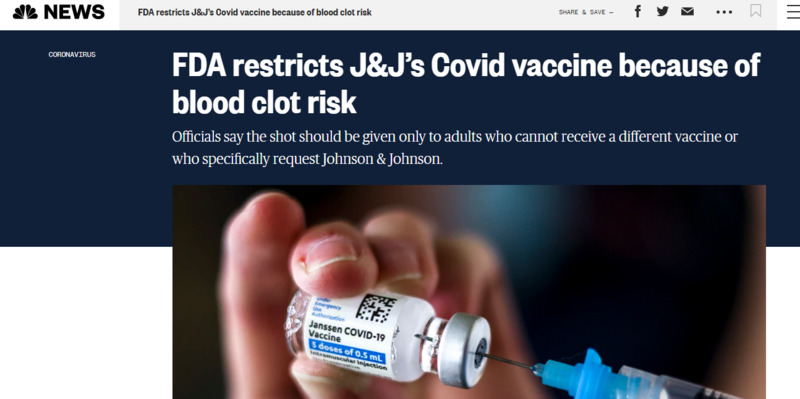 2022-05-05
2022-05-05FDA restricts J&J’s Covid vaccine due to blood clot risk
This is a news story from NBC News by The Associated Press. Due to new findings, the J&J vaccine has been restricted by the FDA due to blood clot risks. It is not to be given to anyone unless they can't receive a different vaccine. Americans are now recommended to only be using Pfizer or Moderna shots instead. -
 2021-04-22
2021-04-22Hospice and hospitals during a pandemic
This is a photo of my grandfather's glasses and a blanket given to him by one of the hospice nurses. He passed in April of 2021, not due to Covid. There were still a lot of Covid restrictions put in place by the hospital, and the hospice center. Everyone had to be checked in at the front desk, temps were taken, questionnaires filled out, and the number of guests at a time was limited. He was moved to a hospice facility down the road from the hospital that he had been in. I was spending 10-12 hours a day with him at this time. He passed very late in the night and the next morning I went to pick up his remaining items. Most I gave to my dad, but I kept the blanket and his glasses. This, I believe, shows a broader picture of the pandemic in relation to healthcare during this time. Everyday healthcare still was taking place, it couldn’t just stop, but they had to adapt. I’ve heard stories from social media and directly from healthcare workers about being exhausted due to the pandemic and Covid guidelines. All I can say is that even after being tired and working through horrible conditions for over a year, every person I talked to for the week that he was there was kind and caring. Healthcare for the last two years has focused a lot of Covid healthcare, which makes sense, but this, in my mind at least, serves as a reminder of the continuous healthcare that has always been happening. I am so grateful for the team of professionals that helped and cared for him that last week. -
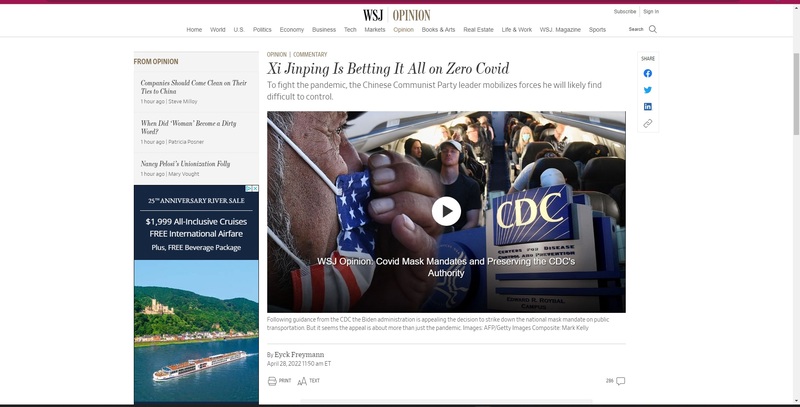 2022-04-28
2022-04-28Xi Jinping Is Betting It All on Zero Covid
This is a news story from The Wall Street Journal by Eyck Freymann. This article is about President Xi Jinping's zero COVID goal. The author argues that this is a risky move for President Xi, as enforcing a zero COVID policy could have many economic ramifications. As of Monday, 45 cities with 373 million people, representing 40% of China’s gross domestic product, were under partial or full lockdown, according to Nomura estimates. More cities and counties are under “static management,” a euphemism for quasi-lockdown. President Xi's COVID policy gets compared to Chairman Mao Zedong's Great Leap Forward, where it can start with a noble intention, but turn deadly for the population. Just like Mao faced great food shortages after the Great Leap Forward, locking down centers that produce a lot of the country's GDP is a risk too. -
 2022-04-18
2022-04-18Natural Medicine
This is an Instagram post by angelicaviator. This person suggests that more natural cures can help with COVID symptoms. Since natural cures don't make profit for the healthcare industry, this is why this person thinks that they are often overlooked. The picture that goes with this has types of juicing suggestions on what goes best against a certain ailment. -
 2022-04-20
2022-04-20"Trust the Science" is Anti-Science
This is an Instagram post by city_slicker_bnswagon. This person is questioning the way we think of the science surrounding COVID. This person thinks that the virus is more political than it is about health. -
 2022-04-22
2022-04-22Happy Earth Day!
This is an Instagram post by hoploninc. This company is wishing everyone a Happy Earth Day. The post itself is relevant because it shows an anthropomorphized version of an earth in a mask, crushing COVID with its foot. Next to it is a personified roll of toilet paper and hand sanitizer. Since the pandemic began, masks and hand sanitizer have become more commonplace to combat COVID. -
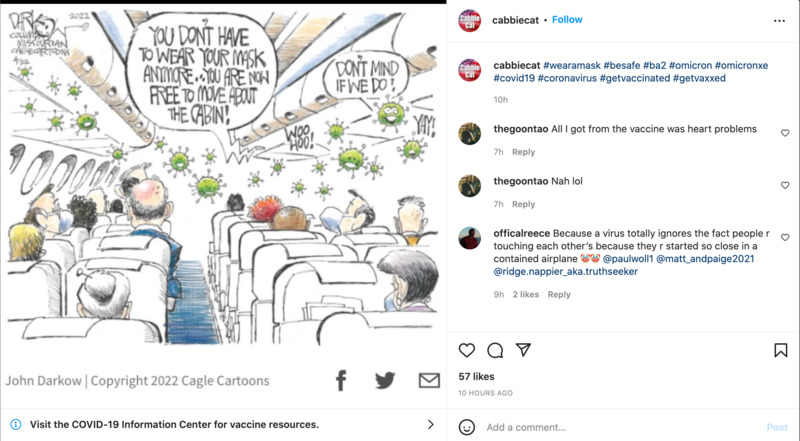 2022-04-22
2022-04-22Wear a Mask
This is an Instagram post by cabbiecat. This user posted a comic that is referencing the recent lift on plane mask mandates in the United States. The comic itself is suggesting that by people removing their masks that COVID will spread easier. -
 2022-04-19
2022-04-19Twitter post in response to masks no longer being federally required on planes
A Twitter user, who works in a hospital, shares her frustrations after masks are no longer federally required on planes. Many people are happy about this ruling, but others, especially those on the "frontlines" in the hospitals, are expressing their frustrations with people acting as if the pandemic is over. -
 2022-04-18
2022-04-18If you have any symptoms
This is a Twitter update by nilikm. This person is a doctor warning people about the symptoms associated with COVID. The doctor advises people to assume they have COVID-19 anyway if they experience the following symptoms, even if they have had it before. The final piece of advice is to isolate longer than five days, as this doctor does not believe that is enough time. -
 2022-04-15
2022-04-15Caring for my husband
This is a Twitter update from Shelby_Thom. She says that her husband became a long-haul COVID patient. He got vestibular neuritis, which causes severe dizziness. He is unable to work or drive. He was a healthy 34-year-old too prior to this, but now hits his head a few days after recovery. -
 2022-04-11
2022-04-11It's Not Over Yet
This is a Twitter update from DrLindaMD. This is about a doctor rebutting claims that COVID is over now. She says that she has had five patients in the last week who thought they just had a cold, but it turned out that they had COVID. None of those patients chose to isolate because "it was just a cold." -
 2022-04-12
2022-04-12Vacuna contra COVID19
This is an Instagram post by eldiariodetlaxcala. This is written in Spanish and is about information for people to get the AstraZeneca vaccine. This event will be held for two days. In the picture, we see volunteers working to help administer the vaccine. Only people 18 and above are eligible for this vaccine, and it is being held in Ocotlán, Tlaxcala. -
 2022-04-11
2022-04-11COVID-19 Testing
This is an Instagram post by medrite_springfieldnj. This is a PSA welcoming people to get free COVID testing. It says that no appointments necessary and walk-ins are welcome. Since the start of the pandemic, rapid testing and PCR tests have become more available and free of charge in many places. The reason many of these are free is due to state and federal governments subsidizing the costs of the tests, in addition to people volunteering to help them get done. -
 2022-04-10
2022-04-10My Expirence with Covid-19
I had Covid twice and my symptoms both times were just cold like symptoms.
